Turning 50, SIAM Revisits a Rich History, Showcases the Work of a Vibrant Community
September 6, 2002
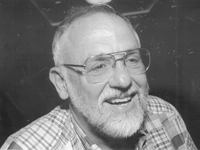
"Right after graduate school," Cleve Moler got a call from Ed Block asking him to join the editorial board of SIAM Journal on Numerical Analysis, and he's "been involved with SIAM ever since." As one of five plenary speakers in Philadelphia, Moler surveyed mathematical software, beginning with the Institute for Numerical Analysis at UCLA (1947-1954) and ending with an equal-opportunity look at the "three M's": Maple, Mathematica, and Matlab.
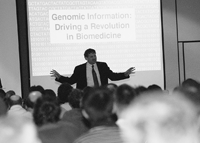
Biology and mathematics have tremendous amounts to say to each other, Eric Lander said in a stimulating John von Neumann Lecture, "The Human Genome and Beyond." Identifying the rate-limiting step in genomics as mathematical and computational analysis, he told a receptive audience that the need is not for computers, but for algorithms.
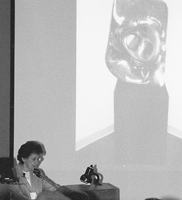
Keynote speaker Rita Colwell, director of the National Science Foundation, described herself as an "unabashed supporter" of SIAM in its emphasis on interdisciplinary research. Citing "golden opportunities for all of you," she included homeland security among "compelling needs" that mathematicians can help meet.
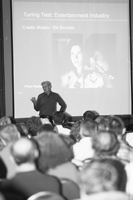
Chris Bregler's I.E. Block Community Lecture, "From Muybridge to Virtual Humans, the Mathematics of Motion Pictures," had many in the audience (Block among them) wondering about the future for actors in the film industry.
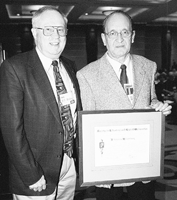
Cited for "inspiring and energetic leadership" in his three years as director of the Division of Mathematical Sciences at NSF, Philippe Tondeur accepted a Frederick A. Howes Commendation for Public Service from H.T. Banks. (As this issue of SIAM News went to press, NSF announced that William Rundell of Texas A&M University would succeed Tondeur as DMS director.)
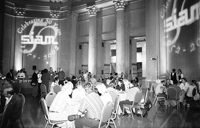
A reception at the Franklin Institute followed Chris Bregler's talk.
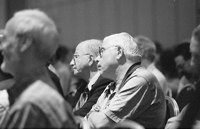
Ed Block, SIAM founder and long-time managing director, listened attentively to his eponymous lecture with an equally rapt Bob Bellace, who retired in 1999 as SIAM's director of finance.

Often on the giving end at SIAM award ceremonies, H.T. Banks (left) accepted the 2002 W.T. and Idalia Reid Prize in Mathematics from SIAM president Tom Manteuffel at the Philadelphia meeting. Banks was cited by the Reid Prize committee "for his fundamental contributions to the theoretical and computational foundations in the identification and control of infinite-dimensional systems."
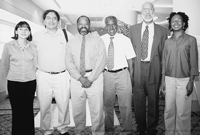
"Diversity Day," a highlight of SIAM meetings since 1995, maintained its momentum in Philadelphia. Participants shown here, from left, are Leticia Vel�zquez, Carlos Castillo-Chavez (who arrived with a busload of students from Cornell), Stacy Hill, Earl Barnes, Bill Hawkins, and Jamylle Carter.
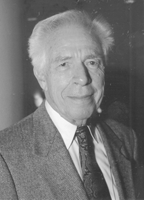
As SIAM's third president (1954-55), Harold Kuhn worked to extend the new society's reach beyond the Philadelphia area. Early milestones he recalled at a July 7 "Retrospective" struck chords with many in the audience.

Opening the SIAM 50th Anniversary Meeting, held in Philadelphia, July 8-12, organizing committee co-chairs Margaret Wright and Martin Golubitsky credited the many people whose talent and hard work went into the meeting's ambitious program. In addition to an award to Connie Young (left) of the SIAM conference department, Golubitsky and Wright had special words of thanks for the other members of the organizing committee: Marsha Berger of the Courant Institute, NYU, Heinz Engl of Johannes Kepler Universit�t, Linz, and Walter Strauss of Brown University.

Sculptor/mathematician Helaman Ferguson (right) provided insight into the intricacies of Double Torus Stonehenge for Marc Jacobs, recently retired from the Air Force Office of Scientific Research, and his wife, Janis. Helaman and Claire Ferguson received this year's JPBM Communications Award, and visitors to the exhibition of his sculptures at the meeting would agree that it was a well-deserved award! Tucked under Jacobs's arm is the Frederick A. Howes Commendation for Public Service, which recognizes his "exemplary service and leadership in the development of research programs in control theory and dynamical systems" in more than a decade at AFOSR.

Marty Golubitsky, pointing out that the program featured some innovations in format, asked for feedback from conference participants. One such feature was a set of four invited "topical" talks given each morning and afternoon of the meeting, with two occurring in parallel at each time slot. (For readers who missed the meeting, Barry Cipra, in the article "Take Two Algorithms and Call Me in the Morning: Mathematical Medicine at SIAM50," reports on work of mathematical and computational scientists at the frontiers of medicine---as described in the nicely complementary topical talks of University of Utah colleagues James Keener and Chris Johnson.)

Right: As president emeritus of NEC Research Institute, former SIAM president Bill Gear (1987-88) has found that retirement affords at least one important benefit: time for research.
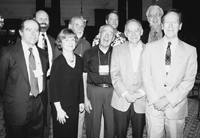
Gathering before the meeting banquet was a subset of the SIAM presidents---past, present, future---in attendance at the 50th Anniversary Meeting: Left to right, back row, Mac Hyman (who takes office on January 1, 2003), Herb Keller (1974-76), current president Tom Manteuffel, and Gene Golub (1985-86); front row, John Guckenheimer (1997-98), Margaret Wright (1995-96), Seymour Parter (1981-82), Avner Friedman (1993-94), and Gil Strang (1999-2000).
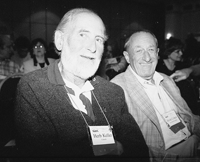
Former SIAM presidents Herb Keller (1974-76) and Hirsh Cohen (1983-84).

Philip Holmes (left), one of the five plenary speakers at the meeting ("How Nonlinear Is Science? Reflections on a Chaotic, Dynamical Century"), and John Guckenheimer, editor-in-chief of DSWeb, the forthcoming Web portal of the SIAM Activity Group on Dynamical Systems. Earlier in the week, Holmes joined Philadelphia area mathematician/poets Jet Wimp and Marion Cohen in a poetry reading, with selections from his new collection, Lighting the Steps.

Scheduling buses for a city the size of Berlin was among the problems touched on by plenary speaker Martin Gr�tschel in a sweeping survey of progress in discrete mathematics and theoretical computer science over the last fifty years. (A preview of the talk, on the combinatorial online optimization problem of scheduling the AAA-type service vehicles known in Germany as "Yellow Angels," appeared in the May issue of SIAM News.)

Enjoying the good company and relaxed ambiance were (left to right) SIAM executive director Jim Crowley, Phil Davis of Brown University (widely loved SIAM News columnist who, 50 years ago, was a member of the editorial board of the first SIAM journal), Avner Friedman (now turning his years of experience as director of the IMA to the benefit of another ambitious institute: the Mathematical Biosciences Institute, at Ohio State University), and AMS executive director John Ewing, whose eloquent congratulations to SIAM put to rest any fears that the early contretemps between the two societies described by Harold Kuhn has had lasting effects.
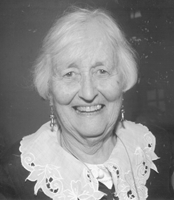
In honor of SIAM's 50th anniversary, the Association for Women in Mathematics (which recently marked its own 25th anniversary) sponsored a special AWM-SIAM invited address. Cathleen Morawetz, shown here at the opening reception, gave the address, which she titled "Existence Theorems: We Need Some More in Fluid Dynamics."
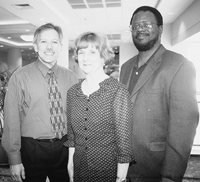
Diversity Day co-chairs Juan Meza (left) and William Massey (right) recognized three people whose exceptional support over the years has made the annual event the success it is today. Shown here is Margaret Wright, who as SIAM president in 1995 provided, in Meza's words, "95% of the energy" that got the tradition started and has made her "a friend to the whole community." Also honored were Earl Barnes, an important presence at every event since 1995, and Richard Tapia, whose legendary energy and enthusiasm have sparked countless sessions of all kinds for minority students.
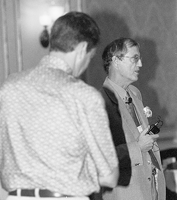
That the future holds abundant opportunities for exciting research in the mathematical sciences was clear to all who attended the SIAM 50th Anniversary Meeting. In from Australia to talk about a specific, and rapidly approaching, future event---ICIAM 03---was Noel Barton (right), who promised a stimulating program and a spectacular setting. Details at http://www.iciam.org.

In her day job, Lois Sellers designs book covers, meeting programs, and just about every product SIAM sends out to its members. Shown here as many saw her during the Philadelphia meeting, she's responsible for the pictures on these pages (with the exception of those from the opening reception, which were shot by her former colleague Robin Miller, and this one).
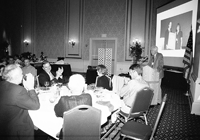
Many at the gala banquet (Thursday, July 11) had the experience of looking up and seeing themselves on the screen in the continuously running (unnarrated) slide show arranged by Jim Crowley.

